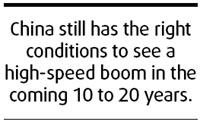Slowdown no reason to spell gloom for growth
By Qin Xiaoying (China Daily)
Updated: 2008-05-15 07:26
Updated: 2008-05-15 07:26
An official from the National Bureau of Statistics predicted in a recent article that the gross domestic product (GDP) of 2008 would grow by less than 11.9 percent, the annual growth achieved in 2007.
He attributed the possible drop in GDP growth to the higher costs of Chinese exports because of the adjustment in export tax rebating policies, the appreciation of the renminbi and the raised labor costs. He also stressed that the export would grow less for the weakened demand because of the economic slowdown in the United States, the European Union and Japan.
His prediction seems to strongly corroborate a popular opinion: that the Chinese economy would see a turning point in 2008.

Admittedly, several bad news have been heard since the year began. The southern and central areas of China were hit by severe snowstorms in winter. How much the devastating earthquake on Monday affects the economy is yet to be assessed. The subprime crisis in the United States triggered a chain of negative influences on the global economy and financial and capital markets. The prices of crude oil and grain on the international market are challenging the Chinese government's efforts of controlling inflation.
All these are "unprecedented challenges" for the Chinese economy and they also make China watchers concerned about the economic outlook this year.
After being useful for three decades, is the fundamental policy of economic reform and opening-up still serving as the engine for economic growth?
My answer is positive.
The economic reform and the opening-up is still driving the industrialization. The primary stage of industrialization with the focus on manufacturing growth has been finished in the coastal areas of China, but it is still going on in the central or western parts.
Moreover, China is achieving remarkably in the production of telecommunication equipment, electronic parts, precision instruments and heavy chemical industry, which indicates an intensification of industrialization in China.
Thanks to this policy, China is now closely integrated with the global economy. Although the export growth might not be so strong because of the renminbi appreciation, China will soon become a big investor with its huge amount of foreign exchange reserve. The outbound investment would benefit both China and the rest of the world.
Also because of the policy, the domestic consumption is to be boosted considerably in view of the continuous economic boom. China would soon have a change in its current role of a big manufacturer, big exporter and modest consumer. The service industry will also be stimulated, which, in turn, would upgrade the country's industrial structure.
Besides all these driving forces, the ongoing urbanization would play a prominent part in maintaining a sustained and fast growth of the Chinese economy.
Alan Greenspan, the former chairman of the Board of Governors of the Federal Reserve in the United States, pointed out in his autobiography, The Age of Turbulence: Adventures in a New World, that one of the major reasons for the low inflation and high economic growth across the world during last 25 years was that about 50 percent of the world's 3-billion labor force entered the competition in the market economy.
Through international trade and investment, the huge group of laborers becomes part of the international industrial chain, which curbs the growth in salary as well as in the overall price level.
What Greenspan described is also valid for the Chinese economy.
Over 150 million rural residents moved into cities in the last three decades. Entering the industries of socialized production under the market economy, these rural residents became the labor resources for nurturing the Chinese processing and manufacturing industries.
The urbanization has also improved the infrastructure in cities and service sectors.
The industries in the Pearl River Delta, the Yangtze River Delta and the Bohai Rim Region will need more labors and the urbanization in the central and western parts of China would accelerate soon. Therefore, the percentage of the rural population would certainly drop further.
The simple fact is that more people living in cities would ensure the potential for economic growth. And what makes us more optimistic is that the urbanization in China is unlikely to cease in the short term.
In short, the slowdown of economic growth is far from an indication of economic downturn. We have solid evidence to support the prediction that China still has the right conditions to see a high-speed boom in the coming 10 to 20 years.
Of course, it would need efforts from the government as well as the public to turn these conditions into real growth. And the first thing among these efforts is to remain modest and carry on with the ongoing reforms.
The author is a researcher with China Foundation for International and Strategic Studies
(China Daily 05/15/2008 page8)
|
|
|
|